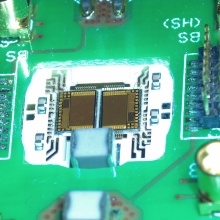Open student thesis
The aim of this call is to develop innovative solutions for researching and programming GaN inverters for BLDC motors in order to maximize the efficiency and performance of these systems. To this end, different commutation schemes will be considered and compared in terms of inverter and motor efficiency.
Kontakt: Jeremy Nuzzo
The aim of this work is to simplify a standard GaN transistor model defined in Verilog-A code by removing less critical functional elements and parameters. The aim is to reduce the complexity of the model while maintaining its accuracy to improve simulation performance.
In modern power electronics, the aim is to increase power density and efficiency. For thermal design and reliability, precise knowledge of switching and conduction losses is of paramount importance. These are not only dependent on the gate-source and drain-source voltage and current, but are also susceptible to degradation. The aim of this work is to develop a degradation model for a transistor. For this purpose, an accelerated lifetime test setup is to be built, with a Peltier element for fast thermal cycling and thus a high acceleration factor of degradation. During the accelerated lifetime test, special parameters are to be characterized repeatedly in order to determine their influence and degradation.
Transistoren auf Basis von Galliumnitrid (GaN) gelten als vielversprechende Bauteile, um fundamentale, materialbedinge Beschränkungen siliciumbasierter Leistungstransistoren zu übertreffen. Doch neben ihren positiven Eigenschaften trüben einige Nachteile das sonst positive Gesamtbild. Eines dieser Probleme ist der sog. „Dynamische RDS,on-Effekt“, welcher die temporäre Erhöhung des Durchgangswiderstandes unmittelbar nach dem Einschalten beschreibt. Gerade bei höheren Schaltfrequenzen, welche durch die Nutzung von GaN-HEMTs angestrebt werden, spielt dieser Effekt also eine große Rolle. In dieser studentischen Arbeit soll der dynamische On-State-Widerstand eines HEMTs vermessen und der Einfluss verschiedener äußerer Parameter untersucht werden.
Arbeitspunkte
- Einarbeitung in die Thematik des dynamischen RDS,on-Effektes
- Einarbeitung in die zugrunde liegende Messmethodik
- Design von Platinen für die Vermessung der HEMTs
- Durchführung von Messreihen, Analyse der erhobenen Daten
- Datenauswertung
- Ausarbeitung und Vortrag
Bedingt durch ihre vorteilhaften Materialeigenschaften sind Transistoren aus Galliumnitrid (GaN) auch für leistungselektronische Anwendungsbereiche attraktiv. Lange Zeit waren für Transistoren dieser Art allerdings nur empirische Modelle verfügbar. In jüngster Vergangenheit wurden von der „Compact Modelling Coalition“, einer Interessengemeinschaft für die Standardisierung von Simulationsmodellen, zwei physikalisch basierte Modelle als Industriestandard vorgeschlagen: das „MIT Virtual Source GaN“ (MVSG) des MIT, sowie das „Advanced Spice Model for HEMTs“ (ASM-HEMT) des IIT Kanpur. In dieser studentischen Arbeit sollen für einen vorliegenden Transistor für beide Modelle ein Parametersatz extrahiert und beide Modelle hinsichtlich ihrer Eigenschaften verglichen werden.
Arbeitspunkte
- Einarbeitung in die Funktionsweise von MVSG und ASM-HEMT
- Charakterisierung eines GaN-HEMTs mit einem Semiconductor Device Analyser
- Parameterextraktion
- Prüfung der resultierenden Transistormodelle
- Ausarbeitung und Vortrag
Contact

Dominik Koch
M.Sc.Group Leader Power Electronics / Research Assistant

Benjamin Schoch
M.Sc.Research Assistant


